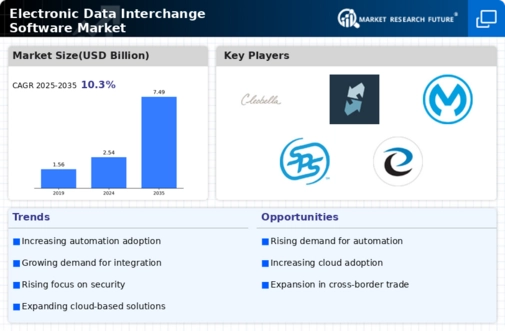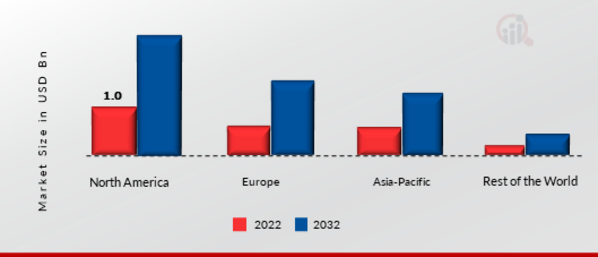-
EXECUTIVE SUMMARY
-
MARKET INTRODUCTION
-
Definition
-
Scope of the Study
- Research Objective
- Assumptions
- Limitations
-
RESEARCH METHODOLOGY
-
Overview
-
Data Mining
-
Secondary Research
-
Primary Research
- Primary Interviews and Information Gathering Process
- Breakdown of Primary Respondents
-
Forecasting Model
-
Market Size Estimation
- Bottom-Up Approach
- Top-Down Approach
-
Data Triangulation
-
Validation
-
MARKET DYNAMICS
-
Overview
-
Drivers
-
Restraints
-
Opportunities
-
MARKET FACTOR ANALYSIS
-
Value Chain Analysis
-
Porter’s Five Forces Analysis
- Bargaining Power of Suppliers
- Bargaining Power of Buyers
- Threat of New Entrants
- Threat of Substitutes
- Intensity of Rivalry
-
COVID-19 Impact Analysis
- Market Impact Analysis
- Regional Impact
- Opportunity and Threat Analysis
-
GLOBAL ELECTRONIC DATA INTERCHANGE (EDI) SOFTWARE MARKET, BY COMPONENT
-
Overview
-
Solution
-
Services
-
GLOBAL ELECTRONIC DATA INTERCHANGE (EDI) SOFTWARE MARKET, BY TYPE
-
Overview
-
Direct EDI
-
EDI via AS2
-
EDI via VAN
-
Mobile EDI
-
Web EDI
-
EDI Outsourcing
-
Others
-
GLOBAL ELECTRONIC DATA INTERCHANGE (EDI) SOFTWARE MARKET, BY INDUSTRY
-
Overview
-
Retail and Consumer Goods
-
BFSI
-
Healthcare
-
IT and Telecommunication
-
Transportation and Logistics
-
Others
-
GLOBAL ELECTRONIC DATA INTERCHANGE (EDI) SOFTWARE MARKET, BY REGION
-
Overview
-
North America
- US
- Canada
-
Europe
- Germany
- France
- UK
- Italy
- Spain
- Rest of Europe
-
Asia-Pacific
- China
- India
- Japan
- South Korea
- Australia
- Rest of Asia-Pacific
-
Rest of the World
- Middle East
- Africa
- Latin America
-
COMPETITIVE LANDSCAPE
-
Overview
-
Competitive Analysis
-
Market Share Analysis
-
Major Growth Strategy in the Global Electronic Data Interchange (EDI) Software Market,
-
Competitive Benchmarking
-
Leading Players in Terms of Number of Developments in the Global Electronic Data Interchange (EDI) Software Market,
-
Key developments and Growth Strategies
- New Product Launch/Service Deployment
- Merger & Acquisitions
- Joint Ventures
-
Major Players Financial Matrix
- Sales & Operating Income, 2022
- Major Players R&D Expenditure. 2022
-
COMPANY PROFILES
-
Cleo
- Company Overview
- Financial Overview
- Products Offered
- Key Developments
- SWOT Analysis
- Key Strategies
-
Comarch SA
- Company Overview
- Financial Overview
- Products Offered
- Key Developments
- SWOT Analysis
- Key Strategies
-
Crossinx GmbH
- Company Overview
- Financial Overview
- Products Offered
- Key Developments
- SWOT Analysis
- Key Strategies
-
Data Masons Software LLC
- Company Overview
- Financial Overview
- Products Offered
- Key Developments
- SWOT Analysis
- Key Strategies
-
EDICOM
- Company Overview
- Financial Overview
- Products Offered
- Key Developments
- SWOT Analysis
- Key Strategies
-
IBM Corporation
- Company Overview
- Financial Overview
- Products Offered
- Key Developments
- SWOT Analysis
- Key Strategies
-
InterTrade Systems, Inc
- Company Overview
- Financial Overview
- Products Offered
- Key Developments
- SWOT Analysis
- Key Strategies
-
MULESOFT, LLC
- Company Overview
- Financial Overview
- Products Offered
- Key Developments
- SWOT Analysis
- Key Strategies
-
SPS Commerce, Inc.
- Company Overview
- Financial Overview
- Products Offered
- Key Developments
- SWOT Analysis
- Key Strategies
-
The Descartes Systems Group Inc.
- Company Overview
- Financial Overview
- Products Offered
- Key Developments
- SWOT Analysis
- Key Strategies
-
TrueCommerce Inc.
- Company Overview
- Financial Overview
- Products Offered
- Key Developments
- SWOT Analysis
- Key Strategies
-
APPENDIX
-
References
-
Related Reports
-
-
LIST OF TABLES
-
GLOBAL ELECTRONIC DATA INTERCHANGE (EDI) SOFTWARE MARKET, SYNOPSIS, 2018-2032
-
GLOBAL ELECTRONIC DATA INTERCHANGE (EDI) SOFTWARE MARKET, ESTIMATES & FORECAST, 2018-2032 (USD BILLION)
-
GLOBAL ELECTRONIC DATA INTERCHANGE (EDI) SOFTWARE MARKET, BY COMPONENT, 2018-2032 (USD BILLION)
-
GLOBAL ELECTRONIC DATA INTERCHANGE (EDI) SOFTWARE MARKET, BY TYPE, 2018-2032 (USD BILLION)
-
GLOBAL ELECTRONIC DATA INTERCHANGE (EDI) SOFTWARE MARKET, BY INDUSTRY, 2018-2032 (USD BILLION)
-
NORTH AMERICA: ELECTRONIC DATA INTERCHANGE (EDI) SOFTWARE MARKET, BY COMPONENT, 2018-2032 (USD BILLION)
-
NORTH AMERICA: ELECTRONIC DATA INTERCHANGE (EDI) SOFTWARE MARKET, BY TYPE, 2018-2032 (USD BILLION)
-
NORTH AMERICA: ELECTRONIC DATA INTERCHANGE (EDI) SOFTWARE MARKET, BY INDUSTRY, 2018-2032 (USD BILLION)
-
US: ELECTRONIC DATA INTERCHANGE (EDI) SOFTWARE MARKET, BY COMPONENT, 2018-2032 (USD BILLION)
-
US: ELECTRONIC DATA INTERCHANGE (EDI) SOFTWARE MARKET, BY TYPE, 2018-2032 (USD BILLION)
-
US: ELECTRONIC DATA INTERCHANGE (EDI) SOFTWARE MARKET, BY INDUSTRY, 2018-2032 (USD BILLION)
-
CANADA: ELECTRONIC DATA INTERCHANGE (EDI) SOFTWARE MARKET, BY COMPONENT, 2018-2032 (USD BILLION)
-
CANADA: ELECTRONIC DATA INTERCHANGE (EDI) SOFTWARE MARKET, BY TYPE, 2018-2032 (USD BILLION)
-
CANADA: ELECTRONIC DATA INTERCHANGE (EDI) SOFTWARE MARKET, BY INDUSTRY, 2018-2032 (USD BILLION)
-
EUROPE: ELECTRONIC DATA INTERCHANGE (EDI) SOFTWARE MARKET, BY COMPONENT, 2018-2032 (USD BILLION)
-
EUROPE: ELECTRONIC DATA INTERCHANGE (EDI) SOFTWARE MARKET, BY TYPE, 2018-2032 (USD BILLION)
-
EUROPE: ELECTRONIC DATA INTERCHANGE (EDI) SOFTWARE MARKET, BY INDUSTRY, 2018-2032 (USD BILLION)
-
GERMANY: ELECTRONIC DATA INTERCHANGE (EDI) SOFTWARE MARKET, BY COMPONENT, 2018-2032 (USD BILLION)
-
GERMANY: ELECTRONIC DATA INTERCHANGE (EDI) SOFTWARE MARKET, BY TYPE, 2018-2032 (USD BILLION)
-
GERMANY: ELECTRONIC DATA INTERCHANGE (EDI) SOFTWARE MARKET, BY INDUSTRY, 2018-2032 (USD BILLION)
-
FRANCE: ELECTRONIC DATA INTERCHANGE (EDI) SOFTWARE MARKET, BY COMPONENT, 2018-2032 (USD BILLION)
-
FRANCE: ELECTRONIC DATA INTERCHANGE (EDI) SOFTWARE MARKET, BY TYPE, 2018-2032 (USD BILLION)
-
FRANCE: ELECTRONIC DATA INTERCHANGE (EDI) SOFTWARE MARKET, BY INDUSTRY, 2018-2032 (USD BILLION)
-
ITALY: ELECTRONIC DATA INTERCHANGE (EDI) SOFTWARE MARKET, BY COMPONENT, 2018-2032 (USD BILLION)
-
ITALY: ELECTRONIC DATA INTERCHANGE (EDI) SOFTWARE MARKET, BY TYPE, 2018-2032 (USD BILLION)
-
ITALY: ELECTRONIC DATA INTERCHANGE (EDI) SOFTWARE MARKET, BY INDUSTRY, 2018-2032 (USD BILLION)
-
SPAIN: ELECTRONIC DATA INTERCHANGE (EDI) SOFTWARE MARKET, BY COMPONENT, 2018-2032 (USD BILLION)
-
SPAIN: ELECTRONIC DATA INTERCHANGE (EDI) SOFTWARE MARKET, BY TYPE, 2018-2032 (USD BILLION)
-
SPAIN: ELECTRONIC DATA INTERCHANGE (EDI) SOFTWARE MARKET, BY INDUSTRY, 2018-2032 (USD BILLION)
-
UK: ELECTRONIC DATA INTERCHANGE (EDI) SOFTWARE MARKET, BY COMPONENT, 2018-2032 (USD BILLION)
-
UK: ELECTRONIC DATA INTERCHANGE (EDI) SOFTWARE MARKET, BY TYPE, 2018-2032 (USD BILLION)
-
UK: ELECTRONIC DATA INTERCHANGE (EDI) SOFTWARE MARKET, BY INDUSTRY, 2018-2032 (USD BILLION)
-
REST OF EUROPE: ELECTRONIC DATA INTERCHANGE (EDI) SOFTWARE MARKET, BY COMPONENT, 2018-2032 (USD BILLION)
-
REST OF EUROPE: ELECTRONIC DATA INTERCHANGE (EDI) SOFTWARE MARKET, BY TYPE, 2018-2032 (USD BILLION)
-
REST OF EUROPE: ELECTRONIC DATA INTERCHANGE (EDI) SOFTWARE MARKET, BY INDUSTRY, 2018-2032 (USD BILLION)
-
ASIA-PACIFIC: ELECTRONIC DATA INTERCHANGE (EDI) SOFTWARE MARKET, BY COMPONENT, 2018-2032 (USD BILLION)
-
ASIA-PACIFIC: ELECTRONIC DATA INTERCHANGE (EDI) SOFTWARE MARKET, BY TYPE, 2018-2032 (USD BILLION)
-
ASIA-PACIFIC: ELECTRONIC DATA INTERCHANGE (EDI) SOFTWARE MARKET, BY INDUSTRY, 2018-2032 (USD BILLION)
-
JAPAN: ELECTRONIC DATA INTERCHANGE (EDI) SOFTWARE MARKET, BY COMPONENT, 2018-2032 (USD BILLION)
-
JAPAN: ELECTRONIC DATA INTERCHANGE (EDI) SOFTWARE MARKET, BY TYPE, 2018-2032 (USD BILLION)
-
JAPAN: ELECTRONIC DATA INTERCHANGE (EDI) SOFTWARE MARKET, BY INDUSTRY, 2018-2032 (USD BILLION)
-
CHINA: ELECTRONIC DATA INTERCHANGE (EDI) SOFTWARE MARKET, BY COMPONENT, 2018-2032 (USD BILLION)
-
CHINA: ELECTRONIC DATA INTERCHANGE (EDI) SOFTWARE MARKET, BY TYPE, 2018-2032 (USD BILLION)
-
CHINA: ELECTRONIC DATA INTERCHANGE (EDI) SOFTWARE MARKET, BY INDUSTRY, 2018-2032 (USD BILLION)
-
INDIA: ELECTRONIC DATA INTERCHANGE (EDI) SOFTWARE MARKET, BY COMPONENT, 2018-2032 (USD BILLION)
-
INDIA: ELECTRONIC DATA INTERCHANGE (EDI) SOFTWARE MARKET, BY TYPE, 2018-2032 (USD BILLION)
-
INDIA: ELECTRONIC DATA INTERCHANGE (EDI) SOFTWARE MARKET, BY INDUSTRY, 2018-2032 (USD BILLION)
-
AUSTRALIA: ELECTRONIC DATA INTERCHANGE (EDI) SOFTWARE MARKET, BY COMPONENT, 2018-2032 (USD BILLION)
-
AUSTRALIA: ELECTRONIC DATA INTERCHANGE (EDI) SOFTWARE MARKET, BY TYPE, 2018-2032 (USD BILLION)
-
AUSTRALIA: ELECTRONIC DATA INTERCHANGE (EDI) SOFTWARE MARKET, BY INDUSTRY, 2018-2032 (USD BILLION)
-
SOUTH KOREA: ELECTRONIC DATA INTERCHANGE (EDI) SOFTWARE MARKET, BY COMPONENT, 2018-2032 (USD BILLION)
-
SOUTH KOREA: ELECTRONIC DATA INTERCHANGE (EDI) SOFTWARE MARKET, BY TYPE, 2018-2032 (USD BILLION)
-
SOUTH KOREA: ELECTRONIC DATA INTERCHANGE (EDI) SOFTWARE MARKET, BY INDUSTRY, 2018-2032 (USD BILLION)
-
REST OF ASIA-PACIFIC: ELECTRONIC DATA INTERCHANGE (EDI) SOFTWARE MARKET, BY COMPONENT, 2018-2032 (USD BILLION)
-
REST OF ASIA-PACIFIC: ELECTRONIC DATA INTERCHANGE (EDI) SOFTWARE MARKET, BY TYPE, 2018-2032 (USD BILLION)
-
REST OF ASIA-PACIFIC: ELECTRONIC DATA INTERCHANGE (EDI) SOFTWARE MARKET, BY INDUSTRY, 2018-2032 (USD BILLION)
-
REST OF THE WORLD: ELECTRONIC DATA INTERCHANGE (EDI) SOFTWARE MARKET, BY COMPONENT, 2018-2032 (USD BILLION)
-
REST OF THE WORLD: ELECTRONIC DATA INTERCHANGE (EDI) SOFTWARE MARKET, BY TYPE, 2018-2032 (USD BILLION)
-
REST OF THE WORLD: ELECTRONIC DATA INTERCHANGE (EDI) SOFTWARE MARKET, BY INDUSTRY, 2018-2032 (USD BILLION)
-
MIDDLE EAST: ELECTRONIC DATA INTERCHANGE (EDI) SOFTWARE MARKET, BY COMPONENT, 2018-2032 (USD BILLION)
-
MIDDLE EAST: ELECTRONIC DATA INTERCHANGE (EDI) SOFTWARE MARKET, BY TYPE, 2018-2032 (USD BILLION)
-
MIDDLE EAST: ELECTRONIC DATA INTERCHANGE (EDI) SOFTWARE MARKET, BY INDUSTRY, 2018-2032 (USD BILLION)
-
AFRICA: ELECTRONIC DATA INTERCHANGE (EDI) SOFTWARE MARKET, BY COMPONENT, 2018-2032 (USD BILLION)
-
AFRICA: ELECTRONIC DATA INTERCHANGE (EDI) SOFTWARE MARKET, BY TYPE, 2018-2032 (USD BILLION)
-
AFRICA: ELECTRONIC DATA INTERCHANGE (EDI) SOFTWARE MARKET, BY INDUSTRY, 2018-2032 (USD BILLION)
-
LATIN AMERICA: ELECTRONIC DATA INTERCHANGE (EDI) SOFTWARE MARKET, BY COMPONENT, 2018-2032 (USD BILLION)
-
LATIN AMERICA: ELECTRONIC DATA INTERCHANGE (EDI) SOFTWARE MARKET, BY TYPE, 2018-2032 (USD BILLION)
-
LATIN AMERICA: ELECTRONIC DATA INTERCHANGE (EDI) SOFTWARE MARKET, BY INDUSTRY, 2018-2032 (USD BILLION)
-
LIST OF FIGURES
-
RESEARCH PROCESS
-
MARKET STRUCTURE FOR THE GLOBAL ELECTRONIC DATA INTERCHANGE (EDI) SOFTWARE MARKET
-
MARKET DYNAMICS FOR THE GLOBAL ELECTRONIC DATA INTERCHANGE (EDI) SOFTWARE MARKET
-
GLOBAL ELECTRONIC DATA INTERCHANGE (EDI) SOFTWARE MARKET, SHARE (%), BY COMPONENT, 2022
-
GLOBAL ELECTRONIC DATA INTERCHANGE (EDI) SOFTWARE MARKET, SHARE (%), BY TYPE, 2022
-
GLOBAL ELECTRONIC DATA INTERCHANGE (EDI) SOFTWARE MARKET, SHARE (%), BY INDUSTRY, 2022
-
GLOBAL ELECTRONIC DATA INTERCHANGE (EDI) SOFTWARE MARKET, SHARE (%), BY REGION, 2022
-
NORTH AMERICA: ELECTRONIC DATA INTERCHANGE (EDI) SOFTWARE MARKET, SHARE (%), BY REGION, 2022
-
EUROPE: ELECTRONIC DATA INTERCHANGE (EDI) SOFTWARE MARKET, SHARE (%), BY REGION, 2022
-
ASIA-PACIFIC: ELECTRONIC DATA INTERCHANGE (EDI) SOFTWARE MARKET, SHARE (%), BY REGION, 2022
-
REST OF THE WORLD: ELECTRONIC DATA INTERCHANGE (EDI) SOFTWARE MARKET, SHARE (%), BY REGION, 2022
-
GLOBAL ELECTRONIC DATA INTERCHANGE (EDI) SOFTWARE MARKET: COMPANY SHARE ANALYSIS, 2022 (%)
-
CLEO: FINANCIAL OVERVIEW SNAPSHOT
-
CLEO: SWOT ANALYSIS
-
COMARCH SA: FINANCIAL OVERVIEW SNAPSHOT
-
COMARCH SA: SWOT ANALYSIS
-
CROSSINX GMBH: FINANCIAL OVERVIEW SNAPSHOT
-
CROSSINX GMBH: SWOT ANALYSIS
-
DATA MASONS SOFTWARE LLC: FINANCIAL OVERVIEW SNAPSHOT
-
DATA MASONS SOFTWARE LLC: SWOT ANALYSIS
-
EDICOM.: FINANCIAL OVERVIEW SNAPSHOT
-
EDICOM.: SWOT ANALYSIS
-
IBM CORPORATION: FINANCIAL OVERVIEW SNAPSHOT
-
IBM CORPORATION: SWOT ANALYSIS
-
INTERTRADE SYSTEMS, INC: FINANCIAL OVERVIEW SNAPSHOT
-
INTERTRADE SYSTEMS, INC: SWOT ANALYSIS
-
MULESOFT, LLC: FINANCIAL OVERVIEW SNAPSHOT
-
MULESOFT, LLC: SWOT ANALYSIS
-
SPS COMMERCE, INC.: FINANCIAL OVERVIEW SNAPSHOT
-
SPS COMMERCE, INC.: SWOT ANALYSIS
-
THE DESCARTES SYSTEMS GROUP INC.: FINANCIAL OVERVIEW SNAPSHOT
-
THE DESCARTES SYSTEMS GROUP INC.: SWOT ANALYSIS
-
TRUECOMMERCE INC.: FINANCIAL OVERVIEW SNAPSHOT
-
TRUECOMMERCE INC.: SWOT ANALYSIS '









Leave a Comment